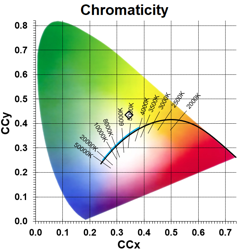
|
Mazda MAF/V Mercury Fluorescent |

The luminescent material is zinc cadmium sulphide activated by copper, (Zn,Cd)S:Cu. It is stimulated by the 365nm UV-A that is able to pass through the hard glass inner arc tube, and produces a weak orange radiation which boosts the red ratio of the lamp from 1% to about 4%. Since the phosphor loses its efficiency above about 150°C, MAF lamps employ a large bulb. This has an isothermal shape to maintain a low surface temperature when operated in the cap-up position.
One drawback of this phosphor is its yellow body colour, which absorbs the violet and blue mercury lines. Despite its own orange radiation and notable improvement in colour rendition, the net result is a rather unpleasant greenish light. This was partly overcome by adding cadmium to the arc, which produces extra blue light. This helps achieve a whiter appearance, but the colour still leaves a lot to be desired and reduces efficacy - 12% drop was claimed, but testing shows 30% less. Cadmium also has a lower vapour pressure than mercury, and to bring it into the plasma the lower end of the arc tube is tapered to increase its temperature.
BTH also made a tubular MAF lamp to fit smaller luminaires, but the phosphor had little benefit due to its hot operation and it was dropped by the early 1940s. At that time the neck of this lamp was lengthened to improve compatibility, and it was produced without further changes until around 1959.




| Manufacturer: | The British Thomson-Houston Co. Ltd. | |
| Lamp Power: | 400 Watts | |
| Lamp Current: | 3.0 Amps | 5.0A during starting |
| Lamp Voltage: | 145 Volts | For 220-230V Mains |
| Cap Type: | E40s/45 | Brass + porcelain |
| Bulb Type: | ED-165 | ED-56 in eighths/inch |
| Bulb Finish: | Zinc Cadmium Sulphide | (Zn,Cd)S:Cu |
| Electrodes: | C-6 Open Coil | Thoria pellet emitter |
| Arc Length: | 160mm | 6¼ inches |
| Atmosphere: | Inner: HgCd | Ar (1 atm) | Outer: Nitrogen |
| Luminous Flux: | 15,200 lm claimed | 11,100 lm measured |
| Luminous Efficacy: | 38.0 lm/W claimed | 27.8 lm/W measured |
| Colour Temperature & CRI: | CCT: 5200K | CRI: Ra 40 |
| Chromaticity Co-ordinates: | CCx: 0.325 | CCy: 0.430 |
| Lifetime: | 5000 hours | |
| Warm-up & Re-strike Time: | 5 minutes | 10 minutes |
| Burning Position: | Vertical cap up | |
| Overall Length: | 335 ± 7.5 mm | 13¼ inches |
| Light Centre Length: | 195 ± 7.5 mm | 7½ inches |
| Factory: | Rugby | England |
| Date of Manufacture: | December 1945 | Date Code: 48 |
| Original Value: | £3 12s 6d | (1947) |

